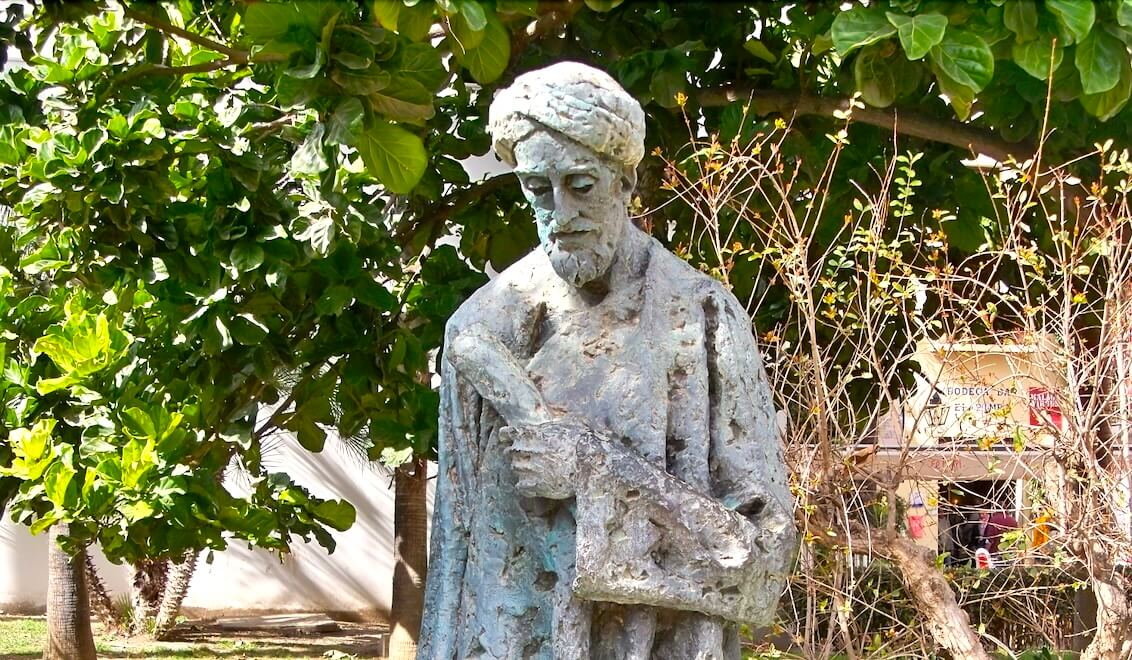Uncle Morris’s Yiddish Handwriting
An unusual request comes from Rabbi Philip Bentley of Agudas Israel Congregation in Hendersonville, N.C.
Rabbi Bentley has sent me the following photocopy of some writing in Hebrew characters, with a signature in English at the bottom:
Accompanying this photocopy is a note: [note: photo removed]
“A non-Jew in the town where I serve as rabbi brought me a copy of a page in his high school autograph book signed by a favorite uncle, who was Jewish. He asked me to translate the message, but the handwriting is either very bad or very strange and I can only tell that it was written in Yiddish. I cannot decipher enough to have any idea of what the message says. It’s a long shot, but I thought maybe you know of someone who might be able to read the text and provide a translation.”
With Rabbi Bentley’s permission, I’ll take a crack at it myself.
Uncle Morris’s Yiddish handwriting is actually neither very bad nor very strange. It’s fairly typical cursive Yiddish script of the period in question, and what makes it difficult for us to decode (it wasn’t so easy for me, either) is its sometimes unconventional spelling, its lack of punctuation and the fact that, far more than cursive Hebrew, it often links together all its letters, giving them unfamiliar forms and making them hard to distinguish.
Take the first word of the first line, for example. (Those of you who cannot read Hebrew characters will have to bear with me.) Since this is an inscription to someone in an autograph book, it might be a reasonable guess that this word might be “To,” which in Yiddish is tsu. And indeed, this is what it is, but the Tsadi and the Vav of tsu are run together and followed by a silent Alef, giving us not ev, as the word would normally be spelled, but rather the strange-looking `ev.
Let’s go on. The next word, the second of line one, is easier to read: Its letters are Bet, Yod, Lamed and Ayin, and they spell bileh. The problem is that there is no such word in Yiddish. But wait a minute: After “To” it would be natural to have someone’s name — and in fact, bileh is quite clearly “Billy,” with its second syllable pronounced in southern fashion. This is confirmed by the next word, spelled Daled, Yod, Nun, which should be read as “Dean.” In short our inscription begins, “To Billy Dean.”
The fourth word of line one is Mem, Yod, Yod, Nun, mayn (“my”), which is hard to make out because its first three letters are linked too. Following it is another word, Nun, Ayin, Feh, Yod, Ayin, nefye, which seems to make no sense until one realizes that it’s the English word “nephew.” It’s followed by Zayin, Yod, Yod, Resh, zeyr (“very”), in which the letters are linked again. Next comes Alef, Feh, Yod, Yod, Nun, Ayin, Resh, afayner, “a fine,” which is idiosyncratically spelled too, the definite article a being run together with fayner in a single word. And the last word of the first line is Bet, Alef, Yod, Yod, which yields boy, another English word. In short, line one reads: “To my nephew Billy Dean, a very fine boy.”
Transcribing the last two lines in the same manner, we get:
ryhpiee hqra rpiin. on xrpiit oiif hree xr rtd ji
o`nqiiee qixen
Or in English:
“I hope he will be a fine man. With my best wishes, Morris Weissman.”
The fascinating thing, I think, is why Uncle Morris chose to write a Yiddish inscription in his nephew Billy’s autograph book. The reason obviously couldn’t have been because Morris Weissman knew no English. Not only do we know that he was Billy’s favorite uncle, which means his English was good enough to communicate with the boy, but his English signature is also perfectly American-looking and his use of such English words as “nephew” instead of Yiddish plimenik, and “boy” instead of yingl, indicates that English was at least partially the language he thought in.
No, I think the explanation has to lie deeper. The year, you’ll note, is 1943. Living in a small town in North Carolina, Morris Weissman, a Yiddish-speaking immigrant from Eastern Europe, knows that his entire family back home is in danger of extermination. Who will remain once all this is over?
We don’t know whether Mr. Weissman has children of his own, but he does have a favorite nephew, a half-Jewish boy named Billy. But will Billy know anything about his Jewish heritage when he grows up? Will he ever want to learn about it? And so Uncle Morris writes Billy a Yiddish inscription in his autograph book, not because he thinks Billy can read it but because he hopes that one day, Billy will want to find out what it means and will have to seek out someone with Jewish knowledge — someone like a rabbi, perhaps, who can teach him about Jewishness.
It took a while, but 63 years later this is what Billy Dean has done. Uncle Morris, I would venture to say, was a very wise man.
Questions for Philologos can be sent to [email protected].
















